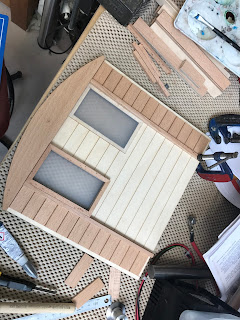This blog will be all about the electronics that drive the tram. It is a bit more text heavy so apologies, although there are a couple of videos!
A lot of the electronics were built during the summer holidays, however throughout the year bits have been added and also removed. Below is the wiring schematic so far, but before we get to bogged down lets look at all the components including the newest part, which was an impulse build - the steam box generator.
I have to say this was not completely my design, and there is a fantastic DIY guide to follow if you wish at the below address:
http://www.wicksteedparkmbc.com/smoke-generator.html
The main difference between the two designs is the water container and how it is controlled, but more on that later.
Here is one of my early prototypes, after changing the water container a couple of times due to not being enough space for the mist to collect above the water. It is a simple design with a PC fan creating draft, which pushes the water vapor up and out of the plastic tube. I also looked at what difference having different sized fans made to the effect.
Here is the test footage, which shows it doing a pretty good job. This is when I started to think how the effect would be vastly improved by having a variable speed, so the faster the motor is going, the more 'steam' is produced. This led to me to test running the fan from the connection which powers the motor, and it worked great - apart from one issue! With this setup, the PC fan sped up and slowed with the motor, but now when the tram is stationery the fan would switch off, producing no 'steam' at all. I played around with the idea of having two fans, with one permanently on and mounted above the other. Another problem I had was the PC fan produced far to much draft when the tram would be stationery. This took me a couple of hours head scratching, but then I had a brain wave.
And this was it, a simple 24V Relay. Check out the wiring diagram below, but the basic idea was to have two power supplies running to the fan, one that was constantly on as soon as power switch was turned, and the other running off the motor power supply. This also powered the magnetic coil, so when enough voltage was applied, it would switch the relay and supply the power from the motor. This worked great, but I was still having the issue of to much draft, which was simply solved by adding a potentiometer into the 'always on circuit' allowing me to adjust the speed of the fan at stationery.
I popped it all in a (very tight fitting) project box. I also added a switch which the fan and misters are wired to, so I can switch the smoke generator off and still run the tram if required.
And this is the final design. The space within the tram is very snug, seeings as I have two batteries (running a 24V system), vs the original design running from one battery (12V system). This led to an interesting dilemma of being able to fit a water container that also had enough space to mount the PC fan. This led to an L-shaped box which was laser cut panels glued together, with a clear acrylic lid on top. A second mister was also added to help produce even more 'steam'.
And this is it, in this video I show the variable speed just from adjusting the potentiometer rather then using the relay and the motor speed controller. The only reason for this is I only had one hand free and it was easier! Once the main body is built and rolling I will post a video showing that circuit working.
This is the circuit diagram you have been waiting for. Apologies for it being rather crude, but I designed it really for the school parents day, and wanted to make it as easy to understand for students and parents as possible. I have separated the main electronics and the newly added smoke generator, just to make it as easy to understand as possible as it has nearly as many components as the main circuits! I think it is pretty straight forward, but let me know if you need any more information.





















